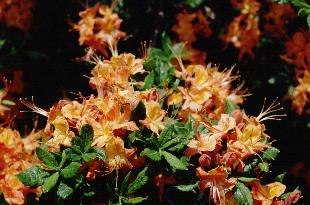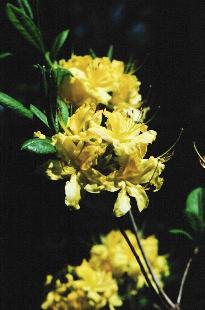


Next: Identifying the Natives
Up: Best of the Best:
Previous: Introduction
 Most people immediately recognize historical sights in Egypt and Rome and they universally acknowledge that mankind must preserve the old buildings and artifacts left from these ancient civilizations. However, few people see anything more than a pretty orange flower when they admire a plant like the Flame Azalea in bloom. Even fewer people have an appreciation for the antiquity of these plants, our native azalea species. The mountains in the eastern United States are among the oldest ranges on the earth, and the variety of native azaleas that grow there are certainly not recent arrivals either. Indeed, our native azaleas are artifacts far older than any outward accomplishments of mankind.
Most people immediately recognize historical sights in Egypt and Rome and they universally acknowledge that mankind must preserve the old buildings and artifacts left from these ancient civilizations. However, few people see anything more than a pretty orange flower when they admire a plant like the Flame Azalea in bloom. Even fewer people have an appreciation for the antiquity of these plants, our native azalea species. The mountains in the eastern United States are among the oldest ranges on the earth, and the variety of native azaleas that grow there are certainly not recent arrivals either. Indeed, our native azaleas are artifacts far older than any outward accomplishments of mankind.
 At first, it may seem surprising that many of the azalea species from around the
world are so closely related. Azaleas like R. luteum from the Caucasus, R.
molle from China, R. japonicum from Japan, and even our West Coast species, R. occidentale, are very closely allied with many of our eastern natives. Yes, our native azaleas are very similar genetically to species from distant lands separated
by thousands of miles, arid deserts, and vast oceans. These plants have not recently traveled to such remote locations by themselves and they were probably not carried around the world by admiring cave men. Instead, they have been quietly
growing in our forests, slowly evolving in local habitats while the rest of the
earth has changed about them.
At first, it may seem surprising that many of the azalea species from around the
world are so closely related. Azaleas like R. luteum from the Caucasus, R.
molle from China, R. japonicum from Japan, and even our West Coast species, R. occidentale, are very closely allied with many of our eastern natives. Yes, our native azaleas are very similar genetically to species from distant lands separated
by thousands of miles, arid deserts, and vast oceans. These plants have not recently traveled to such remote locations by themselves and they were probably not carried around the world by admiring cave men. Instead, they have been quietly
growing in our forests, slowly evolving in local habitats while the rest of the
earth has changed about them.
The late David Leach noted that fossil records in North America and Europe show that certain species in the genus Rhododendron have existed essentially unchanged for at least 50 million years [8]. I suspect that precursors of our native azaleas were probably blooming on "Pangaea", the hypothetical land mass that millions of years ago split apart to form the continents we know today. Similarly, many of the favorite trees and wildflowers we find in our eastern woodlands (dogwoods, magnolias, trilliums, arisaemas, etc.) have counterparts in these same far places of the world. Like our native azaleas, they have survived earthquakes and asteroids, dinosaurs and ice ages but they are facing their most critical test right now, the effects of mankind. We must be certain that these plants can survive the severe disruption to their habitats that we have wrought in just 200 years.



Next: Identifying the Natives
Up: Best of the Best:
Previous: Introduction
Donald W. Hyatt
2001-06-26
 Most people immediately recognize historical sights in Egypt and Rome and they universally acknowledge that mankind must preserve the old buildings and artifacts left from these ancient civilizations. However, few people see anything more than a pretty orange flower when they admire a plant like the Flame Azalea in bloom. Even fewer people have an appreciation for the antiquity of these plants, our native azalea species. The mountains in the eastern United States are among the oldest ranges on the earth, and the variety of native azaleas that grow there are certainly not recent arrivals either. Indeed, our native azaleas are artifacts far older than any outward accomplishments of mankind.
Most people immediately recognize historical sights in Egypt and Rome and they universally acknowledge that mankind must preserve the old buildings and artifacts left from these ancient civilizations. However, few people see anything more than a pretty orange flower when they admire a plant like the Flame Azalea in bloom. Even fewer people have an appreciation for the antiquity of these plants, our native azalea species. The mountains in the eastern United States are among the oldest ranges on the earth, and the variety of native azaleas that grow there are certainly not recent arrivals either. Indeed, our native azaleas are artifacts far older than any outward accomplishments of mankind.
